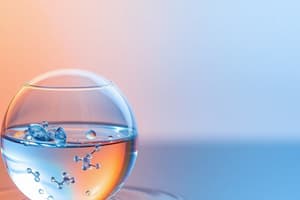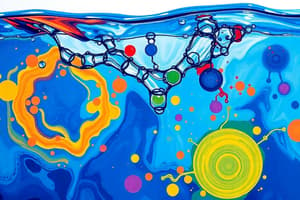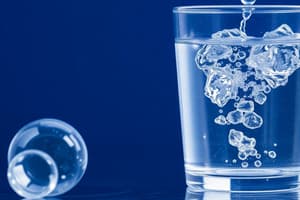Podcast
Questions and Answers
Which property of water allows insects to walk on its surface?
Which property of water allows insects to walk on its surface?
- High specific heat
- Universal solvent properties
- Cohesion due to hydrogen bonds (correct)
- Density as a solid
Which element is the primary building block of life due to its ability to form stable bonds with itself and other elements?
Which element is the primary building block of life due to its ability to form stable bonds with itself and other elements?
- Hydrogen
- Carbon (correct)
- Oxygen
- Nitrogen
What type of bond is formed when electrons are shared between two atoms?
What type of bond is formed when electrons are shared between two atoms?
- Hydrophobic interaction
- Ionic bond
- Covalent bond (correct)
- Hydrogen bond
Which of the following macromolecules is primarily responsible for energy storage in animals?
Which of the following macromolecules is primarily responsible for energy storage in animals?
Which of the following is NOT a function of proteins?
Which of the following is NOT a function of proteins?
What structural feature characterizes RNA but not DNA?
What structural feature characterizes RNA but not DNA?
Which type of interaction is most important in maintaining the secondary structure of a protein?
Which type of interaction is most important in maintaining the secondary structure of a protein?
A researcher discovers a new organic molecule that is mostly nonpolar. Which of the following is the most likely characteristic of this molecule?
A researcher discovers a new organic molecule that is mostly nonpolar. Which of the following is the most likely characteristic of this molecule?
A scientist is analyzing a sample from a newly discovered organism. They find that the genetic material is composed of a molecule similar to DNA, but with several key differences: it's single-stranded, contains the base xanthine instead of guanine, and has a higher proportion of adenine-like bases than cytosine-like bases. Based on this information, which of the following would be the MOST likely conclusion about the base pairing rules in this organism?
A scientist is analyzing a sample from a newly discovered organism. They find that the genetic material is composed of a molecule similar to DNA, but with several key differences: it's single-stranded, contains the base xanthine instead of guanine, and has a higher proportion of adenine-like bases than cytosine-like bases. Based on this information, which of the following would be the MOST likely conclusion about the base pairing rules in this organism?
Imagine a hypothetical biochemical pathway where enzyme A catalyzes the conversion of compound X to compound Y. Compound Y then allosterically inhibits enzyme A. If a mutation caused compound Y to lose its ability to bind to enzyme A, what would be the most likely outcome?
Imagine a hypothetical biochemical pathway where enzyme A catalyzes the conversion of compound X to compound Y. Compound Y then allosterically inhibits enzyme A. If a mutation caused compound Y to lose its ability to bind to enzyme A, what would be the most likely outcome?
Flashcards
Hydrogen Bond
Hydrogen Bond
A weak attraction between a slightly positive hydrogen atom and a slightly negative atom.
Cohesion
Cohesion
The clinging of one substance to itself, due to hydrogen bonds.
Adhesion
Adhesion
The clinging of one substance to another.
Solvent
Solvent
Signup and view all the flashcards
Carbon
Carbon
Signup and view all the flashcards
Functional Groups
Functional Groups
Signup and view all the flashcards
Covalent Bond
Covalent Bond
Signup and view all the flashcards
Macromolecule
Macromolecule
Signup and view all the flashcards
Dehydration Synthesis
Dehydration Synthesis
Signup and view all the flashcards
Hydrolysis
Hydrolysis
Signup and view all the flashcards
Study Notes
Chemistry of Life Overview
- This unit explores the chemical foundations of life, focusing on biological macromolecules like proteins and nucleic acids.
- Aims to provide a better understanding of the chemical properties that make life possible.
Structure of Water and Hydrogen Bonding
- Water's essential role in life is emphasized due to its unique and complex properties.
- Topics covered include hydrogen bonding, capillary action, surface tension, cohesion, adhesion, solvent properties, specific heat, heat of vaporization, and density.
- Importance of water for life is discussed.
Hydrogen Bonding in Water
- Hydrogen bonds are relatively weak bonds that form between water molecules due to their polarity.
- These bonds are responsible for many of water's unique properties.
Hydrogen Bonds in Water
- Water is a polar molecule with a partial positive charge on hydrogen atoms and a partial negative charge on the oxygen atom.
- Positive areas of one water molecule are attracted to negative areas of another, forming a hydrogen bond.
- Each water molecule can form hydrogen bonds with up to four other water molecules.
Capillary Action and Meniscus
- Capillary action is the movement of water within a narrow space due to cohesion and adhesion.
- A meniscus is the curved surface of water in a tube, resulting from adhesion to the tube walls and cohesion among water molecules.
Surface Tension
- Surface tension is the property of a liquid that allows it to resist an external force, due to the cohesive nature of its molecules.
- Water has a high surface tension, allowing small insects to walk on it
Cohesion and Adhesion of Water
- Cohesion is the attraction between water molecules, allowing for high surface tension.
- Adhesion is the attraction between water molecules and other surfaces, aiding capillary action.
Water as a Solvent
- Water's polarity makes it an excellent solvent, capable of dissolving many ionic and polar substances.
- Hydrophilic substances dissolve in water, while hydrophobic substances do not.
Specific Heat, Heat of Vaporization, and Density of Water
- Water has a high specific heat, meaning it requires a lot of energy to change its temperature.
- Water has a high heat of vaporization, requiring a lot of energy to evaporate.
- Water's density is unique because it is less dense as a solid (ice) than as a liquid, allowing ice to float.
Importance of Water for Life
- Water's properties are essential for various biological processes.
- These include temperature regulation, transportation of nutrients, and as a medium for chemical reactions.
Elements of Life
- Focuses on the elements crucial for life, particularly carbon.
- Key concepts include: elements, atoms, carbon's role as a building block, hydrocarbons, functional groups, and elemental building blocks of biological molecules.
Elements and Atoms
- Elements are substances that cannot be broken down into simpler substances by chemical means, composed of atoms.
- Atoms are the smallest unit of matter that retains the chemical properties of an element.
Matter, Elements, and Atoms
- Matter is anything that has mass and takes up space, composed of elements.
- Elements are made of atoms, which consist of protons, neutrons, and electrons.
Carbon as a Building Block of Life
- Carbon is fundamental to life due to its ability to form stable bonds with many other atoms, including itself.
- This allows for the creation of large, complex molecules.
Carbon and Hydrocarbons
- Carbon atoms can form diverse structures, including chains, rings, and branched structures.
- Hydrocarbons are organic molecules consisting entirely of carbon and hydrogen, serving as a primary source of energy.
Functional Groups
- Functional groups are specific groups of atoms attached to carbon skeletons that determine the properties and reactivity of organic molecules.
- Examples include hydroxyl (-OH), carbonyl (C=O), carboxyl (-COOH), amino (-NH2), and phosphate (-PO4).
Elemental Building Blocks of Biological Molecules
- Key elements such as carbon, hydrogen, oxygen, nitrogen, phosphorus, and sulfur are essential for building biological molecules.
- These elements combine to form monomers, which then polymerize into larger macromolecules.
Introduction to Biological Macromolecules
- This section covers the basics of chemical bonds (ionic and covalent) and the introduction to macromolecules.
- Also covered are dehydration synthesis and hydrolysis.
Ionic Bonds
- Ionic bonds are formed through the transfer of electrons between atoms, creating ions (charged particles)
- These bonds occur due to attraction between positive and negative ions.
Covalent Bonds
- Covalent bonds involve the sharing of electrons between atoms.
- They result in a strong bond that holds atoms together in a molecule.
Chemical Bonds
- Chemical bonds are attractive forces that hold atoms together.
- These include ionic bonds, covalent bonds (polar and nonpolar), and hydrogen bonds.
Introduction to Macromolecules
- Macromolecules are large organic molecules necessary for life, including carbohydrates, lipids, proteins, and nucleic acids.
- They are polymers assembled from smaller monomer subunits.
Dehydration Synthesis
- Dehydration synthesis (or condensation reaction) is a chemical reaction where monomers combine to form a polymer by releasing a water molecule.
- This process builds larger molecules from smaller ones.
Hydrolysis
- Hydrolysis is a chemical reaction where a polymer is broken down into monomers by adding a water molecule.
- This process breaks down larger molecules into smaller ones.
Properties, Structure, and Function of Biological Macromolecules
- Focuses on the detailed structure and functions of DNA, RNA, amino acids, proteins, carbohydrates, and lipids (triglycerides).
- Includes saturated, unsaturated, and trans fats.
Molecular Structure of DNA
- DNA is a double-stranded helix composed of nucleotide monomers.
- Each nucleotide consists of a deoxyribose sugar, a phosphate group, and a nitrogenous base (adenine, guanine, cytosine, or thymine).
Antiparallel Structure of DNA Strands
- DNA strands run antiparallel, meaning they are oriented in opposite directions (5' to 3' and 3' to 5').
- This arrangement is crucial for DNA replication and transcription.
Molecular Structure of RNA
- RNA is typically single-stranded and composed of nucleotide monomers.
- Each nucleotide consists of a ribose sugar, a phosphate group, and a nitrogenous base (adenine, guanine, cytosine, or uracil).
Introduction to Amino Acids
- Amino acids are the building blocks of proteins.
- Each amino acid has an amino group, a carboxyl group, a hydrogen atom, and a unique R-group (side chain) attached to a central carbon atom.
Overview of Protein Structure
- Proteins have four levels of structure: primary (amino acid sequence), secondary (local folding patterns like alpha-helices and beta-sheets), tertiary (overall 3D shape), and quaternary (arrangement of multiple polypeptide chains).
Introduction to Carbohydrates
- Carbohydrates are organic molecules composed of carbon, hydrogen, and oxygen in a ratio of 1:2:1.
- They include monosaccharides, disaccharides, and polysaccharides.
Carbohydrates
- Carbohydrates serve as a primary source of energy and provide structural support in cells.
- Monosaccharides (e.g., glucose, fructose) are simple sugars, disaccharides (e.g., sucrose, lactose) are composed of two monosaccharides, and polysaccharides (e.g., starch, cellulose) are complex carbohydrates.
Molecular Structure of Triglycerides (Fats)
- Triglycerides are lipids composed of a glycerol molecule and three fatty acid molecules.
- Fatty acids can be saturated (no double bonds) or unsaturated (one or more double bonds).
Saturated Fats, Unsaturated Fats, and Trans Fats
- Saturated fats are solid at room temperature and have no double bonds between carbon atoms.
- Unsaturated fats are liquid at room temperature and have one or more double bonds.
- Trans fats are a type of unsaturated fat with a specific configuration around the double bond, often produced industrially and associated with health risks.
Biological Macromolecules Review
- Macromolecules are large organic molecules essential for life.
- Carbohydrates, lipids, proteins, and nucleic acids and their respective functions and structures are important.
Nucleic Acids
- Focuses on DNA and RNA molecular structures, and antiparallel structure of DNA strands.
DNA
- DNA (deoxyribonucleic acid) is a nucleic acid carrying genetic instructions for all known living organisms and many viruses.
- DNA consists of two strands that coil around each other to form a double helix.
- The DNA carries genetic information.
Molecular Structure of DNA
- DNA is composed of nucleotide monomers, each consisting of a deoxyribose sugar, a phosphate group, and a nitrogenous base (A, T, C, or G).
- The bases pair specifically: adenine (A) with thymine (T), and guanine (G) with cytosine (C).
Antiparallel Structure of DNA Strands
- DNA strands run antiparallel, meaning they are oriented in opposite directions (5' to 3' and 3' to 5').
- This arrangement allows for proper base pairing and DNA replication.
Molecular Structure of RNA
- RNA (ribonucleic acid) is typically single-stranded and composed of nucleotide monomers.
- Each nucleotide consists of a ribose sugar, a phosphate group, and a nitrogenous base (A, U, C, or G).
Nucleic acids
- Nucleic acids are polymers made of nucleotide monomers.
- DNA and RNA are essential for storing and expressing genetic information.
Studying That Suits You
Use AI to generate personalized quizzes and flashcards to suit your learning preferences.




